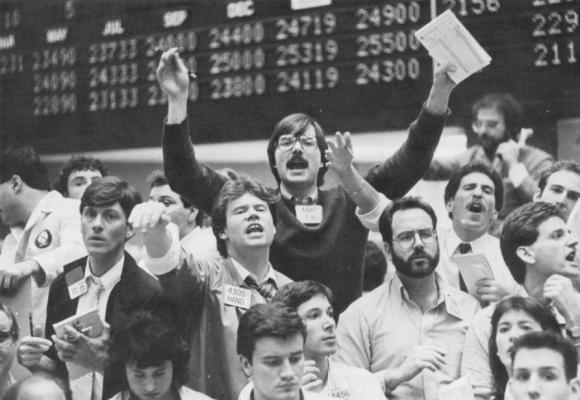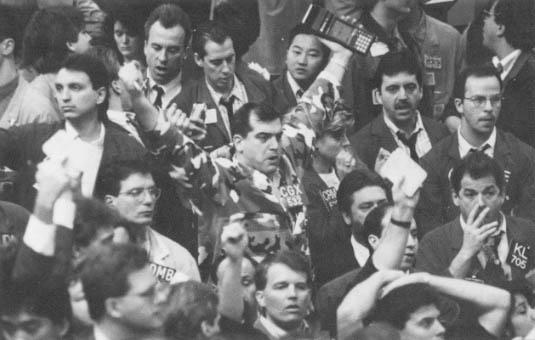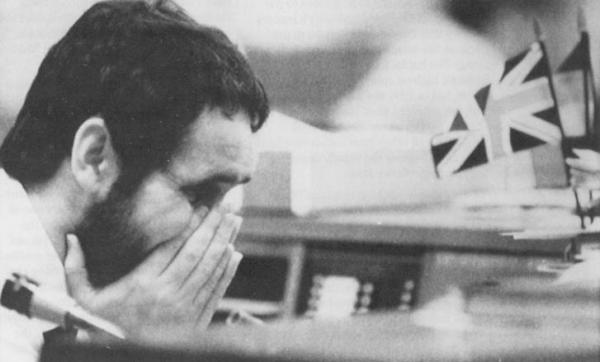Approaching Financial Meltdown
On March 27, an Azerbaijani missile hit an Aeroflot jet and bounced off without exploding. But the news broke into bank trading rooms as rumors of war between Russia and the Ukraine, sending shivers throughout the international currency market.
Just hours after the less dramatic truth had flashed across the Reuters screens, a controversial speculator in currencies sipped a diet Pepsi and spoke softly of a financial system he believes to be in crisis, vulnerable to massive, hidden risks and, like the Aeroflot jet, preserved from explosion only by luck.
Andrew Krieger has bet billions of dollars to make hundreds of millions on educated guesses about the currency markets. In a career with some of the top financial and trading institutions in the world, he has developed a reputation for guts, savvy and extraordinary daring.
At Bankers Trust Company from 1986-1988, he was one of the pioneers leading the U.S. banking industry out of its conservative traditions and into the bold new world of risk taking. By 1992, two-thirds of this federally insured bank's earnings came from speculation and risk management. Krieger himself left the bank in 1988, but huge trades he made while there are so legendary that when Malaysia's central bank began to roil the international currency markets with its own billion-dollar bets, the market buzz said Krieger was behind the strategy.
Krieger is, to put it mildly, no alarmist. But he's clearly worried by the present state of the financial system. The biggest banks no longer make money on safe loans to the biggest companies. Instead, they speculate with investment contracts and financial instruments collectively called derivatives, because they have no value in themselves. Their value is derived from the value of other things--stock market indices, commodity prices, interest rates, foreign exchange rates, etc. Many derivatives are so new and complex that traditional accounting measures cannot even value them accurately.
In many cases these obligations do not appear on the banks' balanc sheeet' because there's no place to put them.
Poorly understood, poorly measured, and massive in scope, these new investments pose inestimable risks to the financial system, which may now be much more vulnerable to panic and collapse than at any time since the 1930's, when regulators carved up the financial industry in hopes of preventing chained bankruptcies. Nearly $4 trillion notional principal of swap contracts, an amount equal to about half the U.S. gross national product, were outstanding by 1992, according to the International Swap Dealers Association (ISDA), an industry group. But swap contracts are only one category of derivatives, and the ISDA information may be understated because not all banks report their activities accurately. "There's a net exposure that is absolutely mindboggling," Krieger said, "It's worse than what people imagine because it's not reported. I think off balance sheet items, in a disaster, are the items that could cause a meltdown." A war in Eastern Furope, or a financial collapse in Japan--whose stock market was plunging to historic lows even as he spoke--could touch off panic, Krieger said. He's not the only market insider saying that these days.
Central bankers fear that a single, big bank failure could bring the entire global financial system to a grinding halt, and question whether banks really understand the risks they are now taking. "These techniques are being applied to a widening variety of underlying transactions," said Richard Farrant, deputy head of banking supervision at the Bank of England, in a speech given on Friday, March 13, at the International Swap Dealers Association conference in Paris. "In the process different markets are being tied more closely together, greatly increasing the potential for shock in one market to be transmitted to others, in ways that may not yet be fully understood."
Time Bombs
At Westpac Banking Corporation’s New York office, senior vice president William Fall sat in a glass booth on the corner of a vast trading room stuffed with blinking computer screens that intense youths watched for price shifts measured in the hundredths of a cent. “Where there is a time bomb possibly waiting to go off is, what has happened is that the market has moved into some very esoteric risks,” he said. Big banks increasingly make huge bets on things they don’t really understand, like commodity prices and stock market values. The odds on these bets are worked out by summa cum laude graduates of top engineering schools or former aerospace and defense researchers trained in mathernatics, astrophysics, and nuclear science. Known collectively as “rocket scientists” or “quant geeks” in the Wall Street argot, at the best firms these bright young things have tens of millions of dollars worth of computer equipment at their disposal. They use it to make models of the economic world, in order to predict which way the financial markets will move. No one, least of all the bank managers or bank regulators, fully understands what the rocket scientists are up to. That, says Fall, is dangerous. “In this institution, as in other institutions, as the risks get more esoteric and mathematical, the faster management is intimidated and doesn’t understand things. Once that’s happened, you’ve lost the connection, you don’t know whether it’s right or wrong,” he warns. Once upon a time, banks tried to minimize risk. No longer. Now, banks make their money from taking risk, and the more risk they take, the more, money they make. Once upon a time, the only risk a bank faced was the risk that a customer would not pay back a loan, and banks were careful to minimize that risk. Now,though, banks are eager to take a bewildering variety of risks. “While industrial and consumer products companies seek to avoid risk, financial firms have to seek out risk to make money,” advises Dominic Casserley, a partner in the New York office of the consulting firm McKinsey & Company, in his new book, Facing Up to the Risks. Casserley says financial institutions that do not seek risk are not doing their job.
Of course, in the United States, it's not just the banks that are taking these risks. Indirectly, through the Federal Deposit Insurance Corporation, it's the taxpayer. "High-tech banking and finance has its place, but it's not all it's cracked up to be," Federal Reserve Bank of New York president E. Gerald Corrigan thundered at an audience of New York bankers in January, "I hope this sounds like a warning, because it is." When the Bank of New England failed, the FDIC took responsibility for its portfolio of derivative instruments. In this instance, fortunately, the derivative portfolio happened to be one of the few profitable activities at the bank.
One of the clearest recent examples of out-of-control derivative markets is Hammersmith & Fulham, a local municipal authority in Great Britain, with fewer residents than Dayton Ohio. The borough took on nearly $10 billion (6 billion pound sterling) of obligations in the swap market when Maggie Thatcher cut back government spending. The borough was not hedging anything. It was speculating for profit, in order to replace money lost to Thatcher's spending cuts. Although the speculation was of questionable legality, Hammersmith & Fulham had no trouble finding banks to deal with.Then, in 1989, interest rates went the wrong way. Hammersmith & Fulham defaulted. In fact, rather than saddle residents with thousands of pounds in new taxes to pay off the banks, the local authority's leaders claimed that they shouldn't have to pay because the swaps had been illegal all along. The banks fought all the way to Britain's highest court, the House of Lords, but in 1991 the Lords ruled that in fact, not only had all of Hammersmith & Fulham's swaps been illegal, but all swaps with all other local authorities had been illegal-even the sound, conservative, non-speculative kind.
International banks lost around $1 billion (500 million pound sterling) in this debacle. But that hasn't stopped banks from continuing to get involved in derivative transactions of dubious legality. Says Allen D. Wheat, Chief Executive of Credit Suisse Financial Products. the derivative banking affiliate of the investment bank Credit Suisse-First Boston, "There still are groups, where you can go through the bylaws and see there's nothing in there that says these guys can do it. A lot of people will not deal with them, but a lot will. That's wrong."
Method in Madness
Wy have banks rushed headlong into risk management? In large part, it’s because traditional banking functions are obsolete. Big, credit worthy industrial corporations are often in better financial shape than their banks. Consequently, these companies can borrow money directly in the capital markets more economically than banks can. They also compete with banks in the lending business.
Since banks are no longer able to lend money to the highest quality borrowers, they have moved into the business of selling a sort of "insurance policy" against market moves that could hurt companies. Banks offer to absorb interest rate, commodity price, stock market or other shocks that could cause problems for a company's bottom line. Although Bankers Trust Company and J.P. Morgan have been the most successful of American banks at reshaping themselves into risk management powerhouses, many banks around the world have to a greater or lesser extent entered the trading and risk management business. In 1985, ten major banks founded the International Swap Dealers Association. Swaps are one of the most important derivative instruments. By 1992, ISDA had 148 members. Most were banks or bank subsidiaries.
It is now becoming clear that the interests of taxpayers and regulators on one hand, and banks on the other, may not always coincide. For example, because banks are paid to take risks, they sometimes have a strong interest in keeping the financial system risky, rather than making it as safe as possible. Some bankers readily admit this. "Definitely one of the considerations that constrains the movement toward taking credit risk out of the system is that the stronger credits have a business interest in anything that will bring business their way based on their credit rating," says Joe Bauman, Managing Director Planning and Analysis at Chemical Bank and Treasurer of the International Swap Dealers Association.
Meeting Real Needs
The risk management business began as a response to real business needs of real customers. Radical changes in the international economic system during the 1970’s removed all stability from currency and interest rates. These changes shocked companies into learning that financial risks were not just the business of green-eyeshaded accountants in a dusty corner of the treasury office. Currency and interest rate moves could make real differences in real business. For example, the largest Caterpillar tractor dealer in the world saw its chief competitor, Komatsu, gain a 40% price advantage when the dollar strengthened against the yen in the early 1980’s. Suddenly, Komatsu could underprice Caterpillar by 40%, not because of better manufacturing techniques but simply because the relationship between the dollar and the yen had changed. Many U.S. manufacturing industries withered under a weak yen onslaught from Japan during this period.
Meanwhile, the U.S. savings and loan industry discovered that it was really in the option business, not the lending business. People with long-term mortgages have a valuable choice: they can prepay their mortgages if they choose. When interest rates fall below the rate on their mortgage, they often do. But if interest rates rise, they will keep their mortgages. This freedom of choice wreaked far more havoc among S&L's than fraud. The industry, which had grown up in an era of government-controlled interest rates, borrowed money from the public through deposits and lent it to homebuyers. Historically, this had never been a problem because deposit interest rates and lending rates were controlled and stable. But in 1979, the Federal Reserve stopped controlling interest rates. By the early 1980's, S&L's had to pay 20% interest rates to attract depositors, who had the option of moving their money elsewhere if rates were better, but were receiving only 6% or 7% on long term mortgages made years before. The borrowers and investors had an option, but the S&Ls did not. Unable to adapt, the industry faced extinction. The S&L's that survived this crisis soon met another. Later in the 1980's, when mortgage interest rates fell, many borrowers exercised their option to prepay old, high rate mortgages and refinance at lower rates.
Wall Street and Chicago responded to the currency and interest volatility with a broad array of new financial instruments that essentially functioned as insurance policies against financial risk. Financial futures, swaps and options all performed the same basic function--they provided companies and financial institutions with an opportunity to hedge against disaster.
Financial futures, traded on century-old exchanges, were standardized and highly regulated. It was not possible, for example, to purchase a futures contract that would provide interest rate protection for more than one year. Using sophisticated mathematics, banks and securities houses found ways to build on futures market technology and developed unregulated, tailor-made contracts for big companies with non-standard needs. These financial hedging techniques met a real need.
By 1992, open interest in financial futures at the Chicago Mercantile Exchange totalled $5 trillion. Swaps and related derivatives not traded on exchanges but rather traded over the counter among banks and dealers approached $4 trillion. Collateralized Mortgage Obligations, a form of derivative favored by real estate lenders and investors, were in the neighborhood of $2 trillion. In short, more than $10 trillion in derivatives, over twice the U.S. national debt, were outstanding.
While the attention of the press and the, public was fixed on Michael Milken and his junk bonds, derivatives were fundamentally transforming the financial structure of the world, virtually unnoticed. "Junk bonds obviously had a significant impact on corporate finance in the U.S.. I think derivatives will have more of a lasting impact than junk bonds," says Brian Walsh, chairman of Bankers Trust International. Merton Miller, Nobel laureate in economics, agrees. In his recent book, Financial Innovations and Market Volatility, Miller writes, "By this standard, my nomination for the most significant financial innovation of the last twenty years is financial futures-the futures exchange style trading of financial instruments."
Although derivatives meet real needs, they also lend themselves easily to abuse. Not all the effects of innovation have been positive. Paul Volcker, the former chairman of the Federal Reserve Board and present chairman of the Group of 30, a prestigous international financial body, says "All of these different instruments can be justified in terms of perfecting markets, there's no doubt about it. From some conceptual standpoint they can all be justified as wonderful tools for hedging. You begin wondering about it when there are more hedges than there are transactions. And what they do is become very easy instruments for speculation in many cases."
For example, J.P. Morgan's 1991 annual report shows that the bank's trading revenue nearly equaled net interest revenue from lending and investing. J.P. Morgan earned nearly.$I.3 billion from speculation and risk management: $626 million from trading swaps and other interest rate contracts, $112 million from trading equities and commodities, $85 million from trading foreign exchange and $474 million from trading bonds.
Although speculation looms large at institutions like Morgan and Bankers Trust, it's not the big banks with the millions of dollars of computer equipment and the bright PhDs, that worry regulators most. It's all of the little banks that have piled into the derivative business expecting easy money. Like nuclear energy, derivatives are most threatening in the hands of small players without proper controls.



